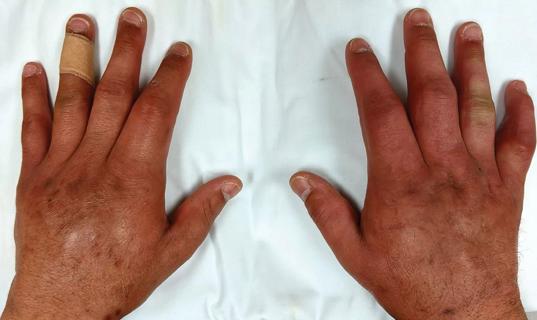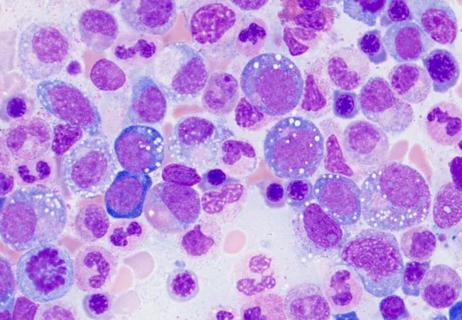New grant to assess potential significance of serial ANA testing

Advertisement
Cleveland Clinic is a non-profit academic medical center. Advertising on our site helps support our mission. We do not endorse non-Cleveland Clinic products or services. Policy
Case 1: D.D. is a 29-year-old African American female with systemic lupus erythematosus (SLE) manifesting with positive antinuclear antibodies (ANA), anti-Smith antibodies, anti-double stranded DNA (dsDNA) antibodies and cytopenias. Clinically, the patient has arthritis, rash, alopecia and oral ulcers. Her ANA titer is > 1:1280 with a homogenous pattern.
Case 2: M.A. is a 22-year-old African American female with SLE with positive ANA, positive anti-dsDNA, low complements, cytopenias with lupus nephritis on hemodialysis, cardiomyopathy and serositis. Her ANA titer is 1:80, with a homogenous pattern.
It is cases such as these that have piqued the interest of rheumatologists in the ANA and its role in SLE. The patient in case 1 has no end organ involvement of her lupus, yet her ANA titer is > 1:1280. In contrast, the patent in case 2 has multi-organ involvement of SLE, with a low positive ANA titer at 1:80.
Are these ANA titers static? Is the absolute number meaningful? Have the titers increased or decreased over the course of the disease? These uncertainties are yet to be elucidated, and are at the core of a recent grant we have accepted from the Lupus Foundation of America.
The diagnosis of SLE is multifaceted requiring clinical symptoms with support of laboratory data. Although standard dogma among rheumatologists is that a patient only needs one ANA test throughout their medical workup, serial testing is nonetheless often performed. The ANA test holds so much weight that new European League Against Rheumatism (EULAR) and the American College of Rheumatology (ACR) classification criteria will require a positive ANA by IFA as entry criterion.
Advertisement
The ANA, by Indirect Immunofluorescence Assay (IFA), is a semiquantitative laboratory test which quantifies the presence of autoantibodies in addition to providing a pattern of nuclear staining. The degree of the ANA titer in addition to staining pattern portend an increased risk for development of autoimmune diseases, and research has found that ANA titers were higher in patients with rheumatic diseases than in healthy individuals. The presence and activity of autoantibodies have been implicated as the driving mechanism of injury and inflammation in this disease. Nevertheless, we have not fully defined the role of these autoantibodies in lupus patients over time.
While one retrospective study using the Department of Defense Serum Repository suggested a progressive accumulation of autoantibodies before the onset of SLE there have been no large-scale studies to assess changes in ANA titers in the same individual over time. Another study from this same data set investigated the use of hydroxychloroquine (HCQ) in the preclinical or asymptomatic phase of patients who went on to develop SLE. Patients who were treated with HCQ had a longer time period before the clinical onset of SLE symptoms compared to those with who were not treated with HCQ and the average number of autoantibodies accrued by the time of diagnosis was higher in patients receiving no prediagnosis HCQ. This suggests that an increase in autoantibodies, as reflected by the ANA test, may mirror the onset or worsening of symptoms. Additionally, this study lends evidence that HCQ can slow or alter the accrual of these antibodies. One proposed mechanism is that HCQ alters the pH in intracytoplasmic vesicles and, thus, the processing and presentation of autoantigenic proteins in MHC class II complexes. This results in a decreased stimulation of CD4-positive T cells reactive with self-peptides, decreased release of cytokines and an overall weakening of the autoimmune process.
Advertisement
In accepting the Gary S. Gilkeson Career Development Award from the Lupus Foundation of America, we plan to characterize trajectories of ANA titers over time in patients with SLE, incomplete SLE and ANA-positive controls without rheumatic disease. After identifying these patients within the electronic health record, we will perform longitudinal modeling, stratified by these three patient groups, to statistically define patterns in positivity and strength of ANAs over time, while accounting for intrapatient correlation. As a secondary aim, we will investigate if HCQ use is associated with changes in ANA positivity or strength, testing the hypothesis that HCQ exposure is associated with a decrease in the prevalence or strength of ANA positivity over time.
This project will allow us to investigate if ANA titers in the same individual change over time and if these changes are clinically meaningful. This is timely in the wake of the Choosing Wisely initiative, which seeks to advance a national dialogue on avoiding unnecessary medical tests, as this grant would address the potential utility of serial ANA testing in lupus patients and provide data to guide decision-making related to ANA ordering.
Advertisement
Advertisement

New clinic meets Hispanic patients where they are

Several factors masked the cause of the patient’s chronic condition

Patient with previous neurological, bone and hematologic involvement presents with hematemesis

Coordinating care across multiple disciplines

A broad differential diagnosis

From methotrexate for RA, to the treatment of HIV and multicenter randomized trials, Cleveland Clinic has long been at the forefront in the field of rheumatology

Study examines the acceptance of PROMs in a large series of rheumatology patients

The identification of a novel disorder: the VEXAS syndrome